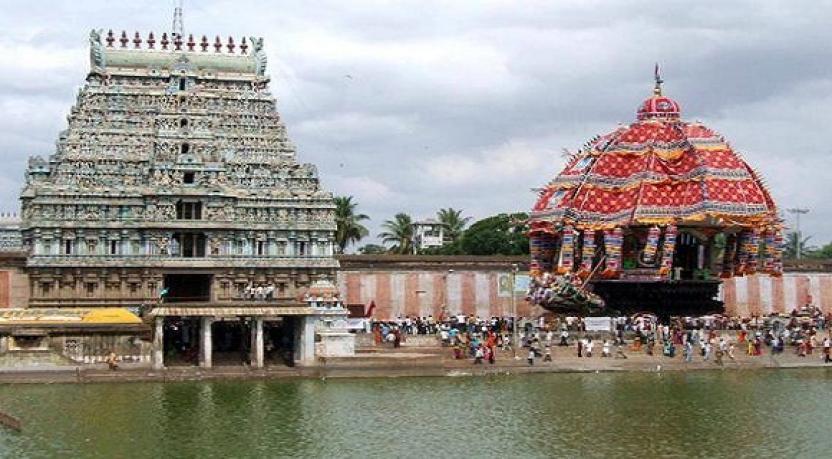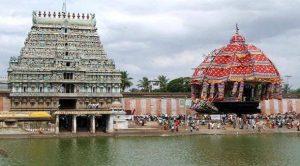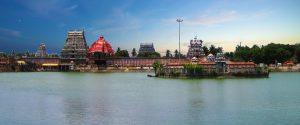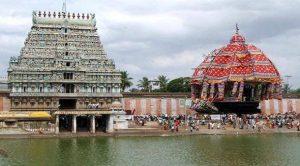Thyagaraja Temple, Tiruvarur, Tamil Nadu
| Date built: | – |
|---|---|
| Deity: | – |
| Architectural style: | Dravidian architecture |
| Major festivals | – |
| Locale: | – |
| District:: | Thiruvarur |
| Address: |
Sannathi Street, Thiruvarur, Tamil Nadu 610001
|
| Phone | 04366242343 |
Thyagaraja Temple is a Shiva temple, located in the town of Thiruvarur in Tamil Nadu, India. Shiva is worshiped as Moolanathar, and is represented by the lingam. Daily poojas are offered to his idol referred to as Maragatha lingam. His consort Parvathi is depicted as Kondi. The presiding deity is revered in the 7th century Tamil Saiva canonical work, the Tevaram, written by Tamil saint poets known as the nayanars and classified as Paadal Petra Sthalam.
The temple complex covers 30 acres, and is one of the largest in India. It houses four gateway towers known as gopurams. The tallest is the eastern tower, with four stories and a height of 30 metres (98 ft). The temple has numerous shrines, with those of Thyagaragar (Veethi Vidangar) and Neelothbalambal (Alliyankothai) being the most prominent.
The temple has six daily rituals at various times from 5:30 a.m. to 10 p.m., and twelve yearly festivals on its calendar. The temple has the largest chariot in Tamil Nadu and the annual festival is celebrated during the month of April.
The present masonry structure was built during the Chola dynasty in the 9th century, while later expansions are attributed to Vijayanagar rulers of the Sangama Dynasty (1336–1485 CE), the Saluva Dynasty and the Tuluva Dynasty (1491–1570 CE). The temple is maintained and administered by the Hindu Religious and Endowment Board of the Government of Tamil Nadu.
Architecture
The temples complex occupies an area of around 33 acres with the Kamalalayam tank to its west. There are numerous shrines and mandapas(halls) in the three spacious enclosures(prakaram). The two main shrines of the temple are for vanmikinathar (Lord Siva) and Thyagarajar. Of the two, the former is the most ancient, and derives its name from tha anthill(putru), which takes the place of linga in the main shrine. Appar, the 7th-century poet saint, refers to the main deity in his hymn as puttritrukondan(one who resides in the ant hill). The Stala vriksham(temple tree) is patiri(trumpet flower tree). The principles and practises of tree-worship and ophilotary are ancient bases whereupon a later date linga worship seems to have been established.
Here all the nine Navagrahas (planetary deities) are located towards south in straight line also located in northwest corner of 1st (prakaram). It is believed that all the planetary deities got relieved off their curse and hence worshiped Thyagaraja. This temple hold the record of having maximum number of shrines (called sannithis in Tamil) in India. The foot of Thyagaraja is shown twice a year and on other occasions it is covered with flowers. The left leg of the deity is displayed during “panguniuthram” festival and right leg on “thiruvathirai”. Some of the major shrines in the temple are of Aananthiswarar, Neelothmbal, Asaleswarar, Adageswarar, Varuneswarar, Annamalieswarar and Kamalambal. The unique feature of the temple is the standing Nandi facing the presiding deity.
The temple has a lot of halls, with six of them being the most prominent. Bhaktha Katchi hall is located to the left of the image of Moosukuntha Nandi. The festival image of Thyagaraja arrives at this hall after the Panguni Uthiram festival. Oonjal hall is located opposite to the Kabatha Katchi hall. The festival images of Chandrasekarar and Sekari Amman arrive at this hall during the Thiruvadhirai festival. Thulapara hall is named after the legend in which king Mucundaka placed Thyagaraja image of Thiruvarur in one and all others in another plate he received from Indra (the king of celestial deities). Purana hall is located in the northern part of the temple. Rajanarayana hall is a public hall for localities of Thiruvaru. Rajendra Chola hall, also called Sababathi hall houses the museum of the temple.
Legend / Local stories
According to legend, a Chola king named Muchukunda obtained a boon from Indra(a celestial deity) and wished to receive an image of Thyagaraja Swamy(presiding deity, Shivain the temple) reposing on the chest of reclining Lord Vishnu. Indra tried to misguide the king and had six other images made, but the king chose the right image at Tiruvarur.
The temple is believed to have been initiated with a large complex by the Pallavas during the 7th century. Contemporary history of the temple dates back to the time of the Medieval Cholas. An inscription dated in the 20th regnal year of Rajendra I(1012–1044) beginning with introduction “Tirumanni valara” is found on the north and west walls of the Thyagaraja shrine.It gives a list of gifts including a number of jewels and lamps to the god veedhividankar(Thyagarajar).It records that the temple was built in stone in the regnal years of the king by Anukkiyar Paravai Nangaiyar.Besides the same lady liberally endowed gold for plating and gilding parts of the vimana,the entrance and the four sides of the shrine.Copper was also donated for plating the doors, corbels of the pillars of the mandapa in front of the shrine.This inscription meticulously records the weight of the endowed gold and copper,besides listing the various ornaments gifted to the temple with description each of them.
The temple complex seems to have acted as the cultural model for the big Brahadeeswarar temple at Thanjavur of Rajaraja Chola I, wherein he enshrined a vitankar which shared with the Adavallan of Chidambaram the status of state cult. The last Chola monarch to play an important role in the affairs of the temple was Kulothunga Chola III in the early part of the 13th century A.D. It attracted saivas of all schools and was important centre of Golaki matha in the 13th and 14th century. It was also an important Jaina dwelling place, which was attacked by saivas, as is evident from Periya Puranam, account of life of tantiyadigal.
Photo Gallery
How to Reach:
Contact Details
Official Address




